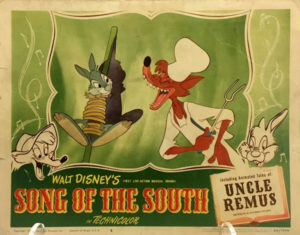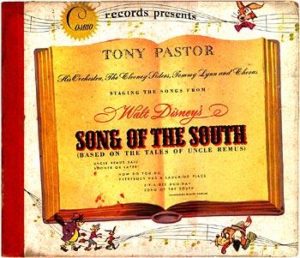
As the seasons of the year 1946 changed from summer to autumn, the staff at the Music Department of the Walt Disney Studios looked forward with some degree of anticipation.
 Disney was readying a new picture for release. And it was going to have several songs in it. None of these would be imports from Central or South America. None of hese would be “evergreens” that wouldn’t make money for Disney, or for whichever music publisher associated itself with the Studio.
Disney was readying a new picture for release. And it was going to have several songs in it. None of these would be imports from Central or South America. None of hese would be “evergreens” that wouldn’t make money for Disney, or for whichever music publisher associated itself with the Studio.
And the publicists and the promotion men and the song-pluggers were all ready and raring to go. And–as it turned out–events proved that they were justified in their anticipation.
As I’ve mentioned in previous Posts, there were a raft of new record companies, providing competition with the established RCA Victor, Columbia and Decca marques.
There were also relatively reliable charts being published every week in trade newspapers, such as “Billboard” and “Cash Box”. These charts measured not only the popularity of individual songs, but of sales in stores, or disk-jockey airplay, and of plays on music machines or “juke boxes”.
The film, so highly anticipated, was Song of the South.
 Not since Pinocchio had the Disney music department seen such interest in songs from one of their films.
Not since Pinocchio had the Disney music department seen such interest in songs from one of their films.
And now, they could see how these discs were doing, relative to one another–and to whatever else was out on the Hit Parade of the day.
Even the smallest record companies got into the act.
Cosmo Records–a company that had managed to snag some moderately big names for such a small firm–put out an “album” of three discs, on which were included six of the songs from this picture.
Not only did the album feature the three songs that got the most coverage–“Zip-A-Dee-Doo-Dah”, the bluesy “Sooner or Later”, and the engaging “Uncle Remus Said”–but it included three others that do not seem to have been otherwise covered. These included the film’s title song, “How Do You Do”, and one that did get at least one other cover, “Everybody Has A Laughing Place”.
Tapped to record these songs was he band of Tony Pastor (born Pesritto), who had made a name for himself playing tenor sax and singing novelties with Artie Shaw’s band (1938-39), then had his own band up until the War. Now, he was back, and had discovered a sister act that he nurtured as best he could. They were Betty and Rosemary Clooney.
The Pastor group also recorded some of these songs for a radio-transcription library as well.
Next Week: More Song of the South – and a battle for supremacy on the charts.


 James Parten has overcome a congenital visual disability to be acknowledged as an expert on the early history of recorded sound. He has a Broadcasting Certificate (Radio Option) from Los Angeles Valley College, class of 1999. He has also been a fan of animated cartoons since childhood.
James Parten has overcome a congenital visual disability to be acknowledged as an expert on the early history of recorded sound. He has a Broadcasting Certificate (Radio Option) from Los Angeles Valley College, class of 1999. He has also been a fan of animated cartoons since childhood.












































A heavenly post. Thank YOOO!!
There is one thing about the Cosmo set (I have copy of it) you should note: these were Rosemary Clooney’s first commercial records!
“How Do You Do?” was covered by Paula Kelly and the Modernaires (Columbia 37170).
In addition to the Johnny Mercer record of “Everybody Has a Laughing Place” on Capitol, the song was also covered by Dick “Two Ton” Baker and His Music Makers (Mercury 5017)
Like many of the post-war independent labels, Cosmo was short-lived, the label declaring bankruptcy in 1947.
In the late 1970s, I ran into a guy named Stubby Pastor who talked a bit about his brother Tony, and Tony’s band. He showed me several LPs with photos of himself with the band on several labels. I ended up searching out Pastor LPs, and found several for myself. I had know about Rosie Clooney, but hadn’t know her start, until I met Stubby.
I have the single sheet music for Sooner Or Later. I love Song Of the South!
With the actual film no longer available in the US, the best way to hear the songs is via Splash Mountain in the Disney Theme Parks.
Ironically, this was how the music from Broadway plays was promoted in the early 1900s.
edbarnes81@cfl.rr.com
Edwin I have a copy of the 3 song Recording
Still in box and in very good condition
What is the value of song of the south cosmo record